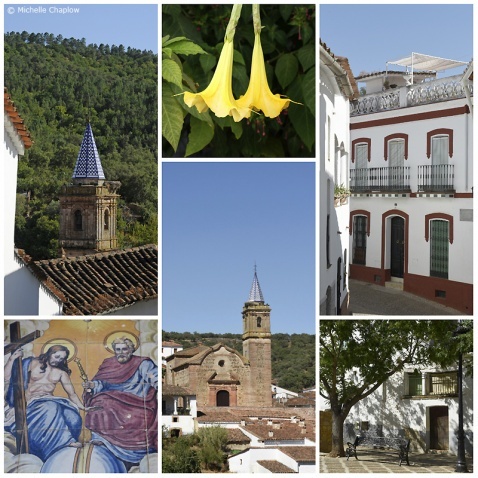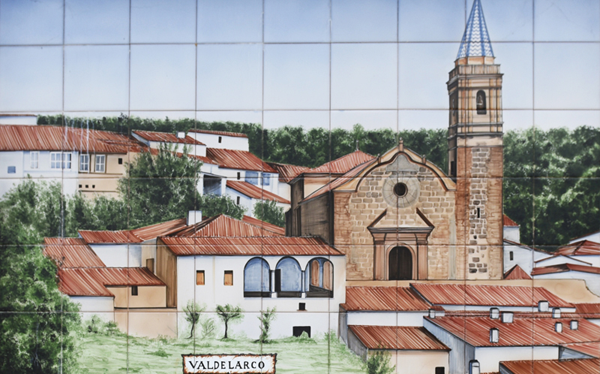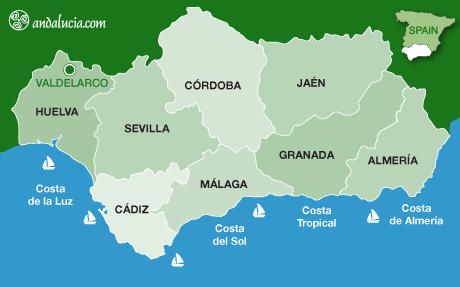
The quaint white village of Valdelarco (click to enlarge photos) © Michelle Chaplow |
|
Valdelarco
Valdelarco is a small village in the north-east of Sierra de Hinojales (Sierra de Aracena) with a population of about 250.
The village is located in a valley between two forested hills, and 6km down the end of the H-8117, a small road off the main N-433. Without any passing traffic, the village is quite secluded.
About two km before the village you will see a sign in the forest which offers you the option to fork left (H-8117) for the higher part of Valdelarco or fork right for the lower part (H-8116).
In the higher part you will find Restaurante Las Catorce Arrobas, with a sign saying 'lo bueno esta dentro' (the best is inside) - the view from the terrace is spectacular. You can drive from here down through the narrow, windy streets to the lower part of the village, but you need to take great care.
In the lower part of the village, you can park near Plaza Antonio Dominguez, where you will find a fountain restored in 2015 and Bar Gordo, and you can take a stroll up to the church, Plaza Ayuntamiento with another fountain. The village's steep, cobbled streets are part of the reason why Valdelarco has been declared of historical and cultural interest.
Things to see
Parish church of the Divine Saviour
Visit the parish church of the Divine Saviour, dating from the 18th century, built by Don Pedro de Silva, Chief Master Builder of the Archbishop of Seville, on the ruins of another destroyed by the Lisbon earthquake of 1761. Note the baroque tower with glazed ceramic capital and its characteristic sundial. Inside, you will find a classical single nave, and a carving of the Virgin of the Rosary. Go through the wrought iron gates of the church and take in the view over the terracotta roof tiles of the houses and their chimney pots.
Mills
Three mills still exist in the village - a flour mill in Calle Estrado, and two olive mills, one on the Camino de Navahermosa and the other in Calle Doctor Adame. Also conserved in the village is the 18th-century cemetery.
OUTSIDE the village
The village is surrounded by forests of cork oak and gall oak. Natural viewpoints nearby include the Risco de la Fuente de la Manzana, two km outside the village on the 'Camino del Regajuelo'.
Ermita de Valdelarco outside the village was built in 1992.
History
The name Valdelarco may come from an ancient arch erected in honour of the Roman Emperor Trajan.
There are ruins of a small necropolis dating from the sixth century BC at Puerto Lanchar.
The history of Valdelarco is similar to all villages of the area, Christian troops of King Ferdinand III reconquered these territories from the Moors (Muslims from North Africa) who populated the region; one Moorish leader was called Mi Miramamen. The area was repopulated in the 13th century, mainly by those from Galicia and Leon. The area was briefly under Portuguese rule in the times of Sancho IV and Alfonso III.
From its founding until Spain was divided into provinces in 1833, the village was part of the Kingdom of Seville, as part of the municipality of Aracena. In the 17th century, along with other villages of the region, it came under the jurisdiction of the Count-Duke of Olivares, and in 1756 it passed to the property of the Duke of Astorga and Count of Altamira. ln 1773 Valdelarco gained its independence from Aracena by Royal Privilege of Exemption granted by Carlos III.
Hotels in Valdelarco
Book Hotels in Valdelarco
Festivals
The Romería del Divino Salvador has been celebrated since the early 1990s, this romeria is in honour of the local patron, and takes place on the first Saturday in May.
Valdelarco celebrates its main festivities in August, also in honour of the Divino Salvador.
In Semana Santa, only Palm Sunday and Resurrecction Sunday (Easter Sunday) are celebrated. On the latter, Valdelarco holds the festival known as Dia del Bolos (Bun Day), when godparents give their godchildren a piece of bread flavoured with aniseed.
Gastronomy
As you'd expect in the Sierra de Huelva, the star ingredient is jamón iberico, as well as chorizo blanco as other products from the Iberian pig. Goat's cheese is also good.
The typical local dish of Valdelarco is caldillo, pork stew, made after the traditional matanza which is still carried out by families in the area.
Location
The village's nearest neighbours are Cumbres Mayores to the north, Cortelazor to the east, Galaroza to the south and La Nava to the west.

